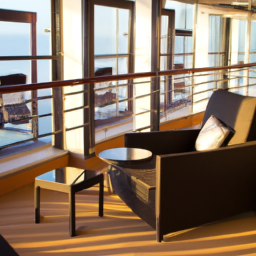Have you ever wondered what it’s like to stay in a cabin on a cruise ship? Well, you’re in luck because in this article, we’re going to dive into the average size of a cabin on a cruise ship. Whether you’re a first-time cruiser or a seasoned traveler, knowing the size of your accommodation can make a big difference in your overall experience. So, let’s get started and explore what you can expect when it comes to the size of cabins on cruise ships.
When it comes to the average size of a cabin on a cruise ship, there’s quite a bit of variation. Generally, cabins can range from around 150 to 300 square feet in size. However, this can vary depending on the cruise line, ship, and cabin category you choose. For those looking for a bit more space, there are also larger suite options available that can be as spacious as 1,000 square feet or more. In addition to the actual size of the cabin, the layout and amenities also play a role in how comfortable and spacious it feels. As you can see, there’s quite a bit to consider when it comes to the size of cabins on cruise ships, and we’ll be exploring all of these details in the rest of this article. So, keep reading to learn more!
Average cabin sizes on cruise ships
Understanding the size ranges
When planning a cruise, one important consideration is the size of the cabin you will be staying in. Understanding the average cabin size on cruise ships can help you make an informed decision about which type of cabin to choose. Cruise ship cabins come in various sizes, ranging from cozy and intimate to spacious and luxurious. Let’s explore the different cabin types and their sizes, as well as the factors that influence cabin sizes.
Different cabin types and their sizes
Cruise ships offer a variety of cabin types to suit different budgets and preferences. The most common cabin types include standard cabins, balcony cabins, and suites/luxury cabins. Each of these cabin types comes with different sizes and amenities.
Standard cabins
Standard cabins are the most common type of cabin found on cruise ships. These cabins are typically compact and offer enough space for a comfortable stay. The average size of a standard cabin usually ranges from 150 to 200 square feet. They are designed to accommodate two passengers and often feature a small sitting area, a bathroom, and a sleeping area with either twin beds or a queen-sized bed.
Balcony cabins
Balcony cabins, also known as veranda cabins, are standard cabins with the added luxury of a private balcony. These cabins allow passengers to enjoy panoramic views of the ocean from the comfort of their own cabin. The size of a balcony cabin is generally the same as a standard cabin, but the addition of a balcony increases the overall living space. Balconies can vary in size, ranging from around 35 to 55 square feet. Passengers who choose a balcony cabin can enjoy the fresh ocean breeze and soak up the sun in their own private outdoor space.
Suites and luxury cabins
For those looking for a more indulgent experience, suites and luxury cabins offer spaciousness and additional amenities. Suites are larger in size and can range from 300 to 500 square feet or more. They often feature a separate sleeping area, a living room space, and a larger bathroom with a bathtub or a whirlpool. Some luxury cabins even include private verandas, dining rooms, and butler service. These cabins are designed for passengers who want a more elevated and exclusive cruising experience.
Factors influencing cabin sizes
Several factors influence the size of cabins on cruise ships. These factors include ship design and style, passenger capacity and demand, as well as price ranges and target demographics.
Ship design and style
Cruise ships come in various designs and styles, ranging from traditional to modern. Traditional cruise ships often have smaller cabins as they were built with a different mindset when personal space wasn’t a priority. On the other hand, modern cruise ships are built with a focus on passenger comfort and satisfaction, resulting in larger cabin sizes and more spacious designs.
Passenger capacity and demand
The number of passengers a cruise ship can accommodate plays a significant role in determining the size of cabins. Ships that cater to a larger number of passengers may have smaller cabins to accommodate everyone comfortably. Conversely, ships with a lower passenger capacity can afford to offer larger cabins to provide a more luxurious experience for their guests.
Additionally, the demand for certain destinations and itineraries can also impact cabin sizes. For popular routes with high demand, cruise lines might opt for larger ships with smaller cabins to cater to a larger number of passengers.
Price ranges and target demographics
Price ranges and target demographics also influence cabin sizes on cruise ships. Higher-priced accommodations such as suites and luxury cabins tend to be more spacious and offer exclusive amenities and services. Cruise lines often tailor the sizes of their cabins to meet the expectations and requirements of their target customers.
Conclusion
In conclusion, the average size of a cabin on a cruise ship varies depending on the type of cabin chosen. Standard cabins are the most common and offer enough space for a cozy stay. Balcony cabins provide the luxury of a private outdoor space, while suites and luxury cabins offer a more indulgent experience with spaciousness and additional amenities. Factors such as ship design, passenger capacity, and demand, as well as price ranges and target demographics, influence the size of cabins. When choosing a cabin on a cruise ship, it is important to consider your individual preferences and needs to ensure a comfortable and enjoyable sailing experience.
